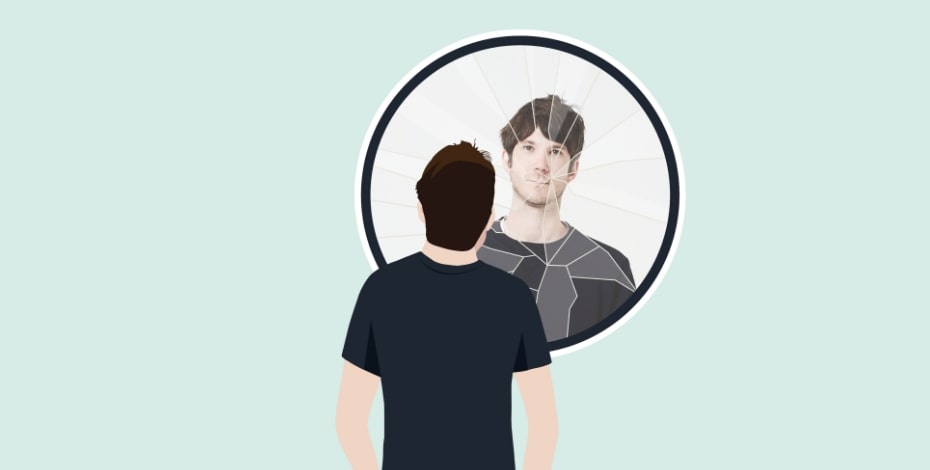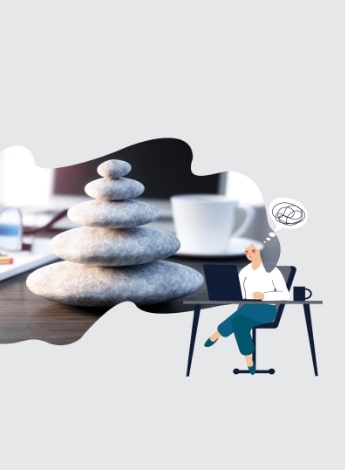
A good look at mental health and self-care

Bronwen Otto explores the prevention and management of mental health disorders in the workplace, while Ellen Lake discusses the role of self-care in physiotherapy.
Mental health at work
Mental health is defined as ‘a state of mental wellbeing that enables people to cope with the stresses of life, realise their abilities, learn well and work well, and contribute to their community’ (World Health Organization 2022a).
Recognition is growing that happy and healthy workers are integral to workplace productivity and business success (Shann & Martin 2017).
There is accumulating evidence and a general consensus in Australia that effective workplace mental health programs are based on an integrated approach across three pillars: prevent harm, promote the positive and manage illness (LaMontagne et al 2014).
Despite substantial research advances to support effective prevention and treatment of mental health disorders (MHDs), however, ‘translation into real-world effects has been painfully slow’ (Patel et al 2018).
Prevalence of MHDs
MHDs are highly prevalent worldwide (World Health Organization 2022b).
Associated with ‘significant distress, impairment in functioning, or risk of self-harm’ (World Health Organization 2022a), MHDs are the leading cause of disability globally (World Health Organization 2022b).
The COVID-19 pandemic has created an additional burden—for example, rates of depression and anxiety increased by more than 25 per cent in the first year of the pandemic (World Health Organization 2022b).
In 2020–2021, more than two in five Australians aged 16–85 years had experienced a MHD at some stage in their life and one in five Australians had a 12-month mental disorder (Australian Bureau of Statistics 2022).
In Australia, workers’ compensation data relating to serious claims shows that work-related stress is responsible for the majority of claims for mental health conditions (Safe Work Australia 2020).
While claims for MHDs are low in number (nine per cent of serious claims) compared to other injuries and illnesses, some concerning trends are evident.
Since 2000–2001, the number of serious claims for MHDs has increased by 28 per cent, median time lost from work due to mental health conditions has increased by 86 per cent and compensation paid for mental health conditions has increased by 209 per cent (Safe Work Australia 2020).
It should be noted that workers’ compensation data is known to be a poor indicator of the true prevalence of the problem (Way 2020).
Who is most vulnerable and at risk for workplace stress?
Studies of exposure to job stressors in the Victorian population and workers’ compensation claims comparisons found that younger workers, working women, workers in lower skilled occupations and precariously employed workers are priority groups for intervention (LaMontagne & Keegal 2012).
Development of work-related MHDs is complex and multifaceted
A work-related MHD (also referred to as a ‘psychological injury’, ‘mental illness’ or ‘mental health condition’) may develop following exposure to work-related psychosocial hazards, with a resulting stress response that is prolonged or extreme (Way 2020).
Work-related stress is described as ‘the physical, mental and emotional reactions of workers who perceive that their work demands exceed their abilities and/or their resources (such as time, help/support) to do their work.
'[Stress] occurs when they perceive they are not coping in situations where it is important to them that they cope’ (SafeWork NSW n.d.).
Work is an important factor contributing to mental and physical health

For the majority of the twentieth century, knowledge about the relationship between health and work was largely limited to the adverse health effects of exposure to physical hazards such as dust and noise.
The positive role of work in health was less well understood and health issues (particularly mental health) were viewed as personal matters outside the realm of work (Way 2020).
Since the end of the century, there has been an increasing body of knowledge about the mental and physical health effects of work-related psychosocial hazards (Way 2020).
Work is now recognised as ‘a key determinant of self-worth’ and the work environment is considered an important factor contributing to health and wellbeing (Black 2008).
There is evidence that better health outcomes are more likely in people who are employed in ‘good work’ than people who are unemployed (Waddell 2006), while people in poor-quality jobs reported similar health to those who were unemployed (Broom et al 2006).
This has led to a recognition that the quality of work matters (LaMontagne et al 2014, Broom et al 2006).
‘Good work’ has been described as ‘healthy and safe work where the hazards and risks are eliminated or minimised so far as is reasonably practicable.
Good work is also where the work design optimises human performance, job satisfaction and productivity’ (Safe Work Australia n.d.).
Opportunity and risk
According to the World Health Organization, workplaces can provide ‘both opportunity and risk for mental health’ (World Health Organization 2022b).
Psychosocial hazards ‘relate to how work is organised, social factors at work and aspects of the work environment, equipment and hazardous tasks’ (International Organization for Standardization 2021).
Common examples of psychosocial hazards include high or low job demands, low job control, poor support from managers or colleagues, lack of role clarity, poor management of change, inadequate reward and recognition and poor organisational justice (Safe Work Australia 2022).
Exposure to work-related psychosocial hazards is rapidly rising and these hazards are increasingly being recognised as a major workplace health and safety challenge (Way 2020).
For example, in many workplaces a high frequency of change has become the norm (Macdonald 2003).
There is an expectation that employees will ‘do more with less’, creating a challenge for managers ‘to maintain their organisation’s economic viability while also protecting the physical and psychological wellbeing of their workforce’ (Macdonald 2003).
The COVID pandemic has then introduced additional sources of stress, from increasing personal financial pressure to social isolation, fear of infection and the threat of job loss (Shaw et al 2020).
An opportunity exists to prevent a substantial proportion of MHDs by avoiding or reducing exposure to work-related psychosocial hazards and by improving the psychosocial quality of work (LaMontagne et al 2014).
A study conducted among working Victorians estimated the prevalence of job-strain-attributable depression to be 13.2 per cent in men and 17.2 per cent in women (LaMontagne et al 2008).
In addition to highlighting the potential opportunity to reduce depression by controlling job strain alone, the study presents an even greater opportunity to reduce additional MHDs by controlling all relevant work-related psychosocial hazards (LaMontagne & Keegal 2012).
Prevention and management of work-related MHDs
The World Health Organization’s definition of a healthy workplace references collaboration between workers and managers; the use of a continual improvement process to protect and promote worker health, safety and wellbeing; and consideration of the physical and psychosocial work environment, personal health resources and community participation (World Health Organization 2010).
Due to the complex aetiology associated with the development of work-related MHDs, prevention and management of MHDs requires ‘systems approaches [that integrate] primary with worker-directed secondary and illness-directed tertiary intervention’ (LaMontagne et al 2007).
Such an approach has been developed by LaMontagne and colleagues, based on three components: prevent harm (by reducing work-related risk factors), promote the positive (by developing the positive aspects of work and worker strengths) and manage illness (regardless of the cause) (LaMontagne et al 2014).
‘Meaningful’ worker participation in the development and implementation of MHD prevention programs is particularly important (LaMontagne et al 2014, International Organization for Standardization 2021).
As psychosocial hazards interface with the core of work (including its design and management) (Way 2020), line leaders also play an integral role in influencing the health, wellbeing and performance of workers (Black 2008).
Barriers to effective prevention of work-related MHDs
There are many barriers to effective prevention of work-related MHDs in real-world settings—for example, a focus on implementing controls at the individual level, a lack of knowledge and skills in risk management of psychosocial hazards and inadequate funding (Oakman et al 2019).

Bronwen Otto.
Available evidence suggests that workplaces fail to identify, assess and control risks associated with work-related psychosocial hazards (Macdonald & Oakman 2015).
There is a tendency for workplaces to limit their approach to the development and implementation of MHD prevention programs focused on changing the individual (eg, resilience training, mindfulness training, yoga or Employee Assistance Program counselling) as opposed to risk management of hazards arising from work organisation, job design or the workplace environment (Oakman et al 2019).
While programs that raise awareness and support workers suffering from an MHD are part of the equation, they should not be the sole focus of workplace mental health programs.
Workplace policies and procedures relating to psychosocial factors are predominantly limited to personal factors such as individual stress management (Oakman et al 2019).
A recent Australian study highlighted a lack of knowledge and skills in risk management of work-related psychosocial hazards in workplace managers (Oakman et al 2019).
Despite the challenges associated with managing psychosocial hazards in the workplace, ‘these hazards can, and should, be managed in the same manner as any other OHS hazard’ (Way 2020).
As the development and implementation of effective MHD prevention interventions requires a systems approach, with controls tailored to particular groups of workers, this can be viewed as ‘labour intensive’ and costly (LaMontagne et al 2014).
Physiotherapists are integral to the prevention and management of work-related MHDs
Many workers with current MHDs actively participate in the workforce (Sanderson & Andrews 2006).
Given that mental health ‘is an intrinsic part of our individual and collective health and wellbeing’ (World Health Organization 2022b) and substantial evidence supports the potential effect of workplace organisational, social and environmental factors on workers’ health and wellbeing, clinical treatment alone may be insufficient in reducing the impact of MHDs (Sanderson & Andrews 2006).
As with any work-related injury or illness, early return to work has a significant impact on a person’s functional and overall recovery from mental illness (Harvey et al 2014).
If treatment outcomes are to be effective and sustainable, a biopsychosocial approach that considers ‘the biological, psychological and social factors that influence a person’s health as part of their assessment and treatment interventions’ (WorkSafe Victoria 2012) must be taken.
It is important for physiotherapists to work closely with employers to ensure that risks associated with relevant psychosocial hazards are identified, assessed, controlled and monitored (Way 2020).
>> Bronwen Otto APAM FACP is a Specialist Occupational Health Physiotherapist (as awarded by the Australian College of Physiotherapists in 2008) and an APA Occupational Health Physiotherapist.
Is it time to integrate self-care into physiotherapy practice?
Self-care is described as an ethical imperative by the Australian Psychological Society, with an important role in preventing clinical distress and impairment (Australian Psychological Society 2015).
In social work, self-care is officially acknowledged in professional documentation and self-care education helps to support social workers facing wellbeing challenges due to workplace stressors such as under-resourcing, high client numbers, clients with complex needs and vicarious trauma (Australian Association of Social Workers 2017).
At a virtual summit in 2020, Occupational Therapy Australia asked the question ‘Why don’t we care for ourselves?’ describing professional caregivers as ‘continuously extending empathy to clients with intense and complex needs’ (Occupational Therapy Australia n.d.).
Physiotherapy workplace stress
Within our own profession, there is a growing acknowledgement that workplace stress affects practitioner wellbeing (Brooke et al 2020, Arkwright & Debenham 2018).
Physiotherapists have high physical workloads and invest emotionally, working empathically with clients who have complex physical and psychological needs and with vulnerable communities, including survivors of trauma and torture (McGrath et al 2021, Heywood et al 2022, Burri et al 2022).
Burnout, defined by the World Health Organization as an occupational phenomenon, is reported globally within physiotherapy (Pieniazek et al 2018, Seixas et al 2020).
A recent systematic review identifying 53 risk factors for physiotherapy burnout described 49 factors as avoidable and four factors as unavoidable (Burri et al 2022).
The highest category of avoidable factors was structural and organisational factors (32 per cent), followed by psychological and emotional (19 per cent), environmental (19 per cent) and sociodemographic (13 per cent).
Structural factors included levels of financial satisfaction, high workloads and work hours and unsatisfactory organisational structures.
Psychological and emotional factors related to unsatisfactory work relationships or social supports, insufficient coping strategies, boredom and lack of challenge, and lack of management and supervisor support.
Work settings and inadequate resources figured highest in environmental factors and sociodemographic factors included the absence of a partner, poor health and a greater number of work-related musculoskeletal disorders or pain sites.
Unavoidable risk factors included fewer years of experience, age at both ends of the spectrum (both younger and older ages carried more risk), fewer years of employment at a specific facility and gender.
Gender was reviewed in 13 studies, with being male a risk factor in seven studies and being female a risk factor in six studies.
It was unclear in this study whether gender referred to the sex assigned at birth or to the gender identified with by the individual and it may well be that gender results reflect differing confounding variables.
A recent Finnish study examining psychological distress (non-specific symptoms of stress, anxiety and depression) reported links between women, higher distress and family–work conflict (Viertio et al 2021).
Men, in this Finnish study, reported higher workplace distress in relationship to conflict with others at work.
Is there a place for self-care in burnout prevention and management?
This long list of risk factors is both alarming and useful.
Understanding risk factors helps to identify contributions to our own workplace stress and assists organisations and policymakers to address structural and organisational issues that contribute to burnout.
Dr Christina Maslach, co-author of Maslach Burnout Inventory, defines burnout as ‘a cumulative negative reaction to constant occupational stressors relating to the misfit between workers and their designated jobs.
'In this sense, burnout is a psychological syndrome of chronic exhaustion, cynicism and inefficacy and is experienced as a prolonged response to chronic stressors in the workplace’ (Maslach et al 1996).
In a later interview, Dr Maslach goes on to say that self-care is not the answer to burnout and can be detrimental in shifting attention away from the employer (Moss 2020).
While it is worth acknowledging that this shift in narrative from individual responsibility to workplace responsibility is beneficial and that burnout cannot be addressed simply by individual efforts or wellbeing programs, self-care has been shown to ‘reduce the risks of ethical violation, promote and model growth and wellbeing, enhance the therapeutic relationship and provide protection from occupational hazards’ (Wityk 2002).
Self-care may not be a ‘cure’ for burnout, but maybe that is not what self-care is designed to do.
In dismissing self-care for not solving the problem of burnout or for deflecting responsibility, we are, perhaps, dismissing its purpose and benefits.
What is self-care and why does it matter?
The term ‘self-care’ can appear self-explanatory, pointing to the process of caring for oneself, and can conjure up images of scented candles, massages and yoga.
In reality, self-care is more than this, both generally and in the workplace.
Within psychology, an accepted definition is ‘providing adequate attention to one’s own physical and psychological wellness’ (Beauchamp & Childress 2001).

Self-care in psychological practice is seen as both an aspirational goal and an ‘ethical imperative’.
Psychologists, social workers, counsellors and other mental health practitioners are ethically directed to practise self-care to support physical, emotional and psychological health and capacity.
Self-care is also a broader concept when viewed through the definition of the World Health Organization as ‘the ability of individuals, families and communities to promote their own health, prevent disease, maintain health, and to cope with illness and disability with or without the support of a health worker’ (World Health Organization 2022).
Although this is primarily focused on the prevention and management of disease, disability and illness, it can be helpful to think about self-care in terms of ‘promoting’, ‘preventing’, ‘maintaining’ and ‘coping’.
Self-care, as defined here, is both an ability (integrating skills, knowledge, awareness and actions) and a process, evolving over time.
It is an active, intentional process designed for a purpose and is as relevant for someone managing workplace and life stress as it is for someone managing a health condition such as diabetes.
The value of frameworks
Frameworks provide conceptual structures and organisational templates that serve as a guide for implementation and evaluation.
One example of a self-care framework is the 7 Pillars of Self-Care, first popularised by the International Self-Care Foundation and endorsed by the Australian Self-Care Alliance (Australian Self-Care Alliance 2022).
This framework addresses:
- knowledge and health literacy
- mental wellbeing
- physical activity
- healthy eating
- risk avoidance
- good hygiene
- rational use of products and services.
Other frameworks include wellbeing models, such as the Eight Dimensions of Wellness proposed by the Substance Abuse and Mental Health Services Administration; the National Strategic Framework for Aboriginal and Torres Strait Islander Peoples’ Mental Health and Social and Emotional Wellbeing 2017–2023 (Australian Institute of Health and Welfare 2022), which recognises that connection to land, sea, culture and spirituality all influence wellbeing; and the Five Ways to Wellbeing model by the Black Dog Institute (Black Dog Institute 2022).

Ellen Lake.
It is important to note that the World Health Organization definition of self-care includes ‘individuals, families and communities’.
Self-care does not operate in isolation.
The Australian Self-Care Alliance proposes a self-care matrix, a unifying framework for self-care that incorporates all levels of public health, integrating personal self-care into higher healthcare and structural systems.
The Five Ways to Wellbeing also incorporates personal wellbeing into workplace structures and systems.
An integrated system of self-care acknowledges the interrelationships between the personal and the professional domain.
Understanding that self-care is not the sole responsibility of the individual is essential to understanding that integrating self-care into physiotherapy practice requires the establishment of frameworks and higher structures.
Examples of higher structural integration include embedding self-care education and practice into undergraduate and postgraduate training, developing peer-to-peer support networks and providing opportunities for psychological debriefing and training in psychological coping strategies.
Self-care benefits us all
A positive therapeutic relationship is an essential component of working within a person-centred model of care and empathic concern and a desire for perspective-taking on the part of the practitioner are contributing qualities.
Personal practitioner distress has been shown to interfere with this relationship and adversely affect therapeutic outcomes (Rodriguez-Nogueira et al 2022).
Incorporating self-care into our personal and professional lives may help to mitigate personal distress and support the physical and psychological wellbeing of both ourselves and our patients.
While not a ‘cure’ for burnout, self-care does offer opportunities for supporting physiotherapist wellbeing.
Integrating self-care concepts into higher organisational structures is a way of fostering collaboration and supporting wellbeing in the workplace.
>> Ellen Lake APAM is a clinical physiotherapist, counsellor and psychotherapist and is currently chair of the APA Mental Health national group.
- References
-
1. World Health Organization (WHO) (June 2022). Mental Health: Strengthening Our Response. Fact Sheet. https://www.who.int/news-room/fact-sheets/detail/mental-health-strengthening-our-response. Referred to in the text as World Health Organization 2022a.
2. Shann, C. & Martin, A. (2017). An Integrated Approach to Workplace Mental Health. Nine Priorities for Implementation in Australia. A White Paper Produced by the University of Tasmania’s Work, Health & Wellbeing Network in Collaboration with National and International Researchers, Practitioners and Policy Makers. https://www.utas.edu.au/__data/assets/pdf_file/0008/972395/WHW-Network-White-Paper.pdf
3. LaMontagne, A.D., Martin, A., Page, K.M., Reavley, N., Noblet, A.J., Milner, A.J., Keegel, T., & Smith, P.M. (2014). Workplace mental health: developing an integrated intervention approach. BMC Psychiatry, 14, 131-141
4. Patel, V., Saxena, S., Lund, C., Thornicroft, G., Baingana, F., Bolton, P., Chisholm, D., Collins, P.Y., Cooper, J.L., Eaton, J., Herrman, H., Herzallah, M.M., Huang, Y., Jordans, M.J.D., Kleinman, A., Medina-Mora, M.E., Morgan, E., Niaz, U., Omigbodun, O., Prince, M., Rahman, A., Saraceno, B., Sarkar, B.K., De Silva, M., Singh, I., Stein, D.J., Sunkel, C., & Unutzer, J. (2018). The Lancet Commission on global mental health and sustainable development. Lancet, 392, 1553-98. https://doi.org/10.1016/S0140-6736(18)31612-X
5. WHO (2022). World Mental Health Report. Transforming Mental Health For All. https://www.who.int/teams/mental-health-and-substance-use/world-mental-health-report. Referred to in the text as World Health Organization 2022b.
6. Australian Bureau of Statistics. (2022). National Study of Mental Health and Wellbeing. Summary Statistics on Key Mental Health Issues Including the Prevalence of Mental Disorders and the Use of Services. https://www.abs.gov.au/statistics/health/mental-health/national-study-mental-health-and-wellbeing/latest-release
7. Safe Work Australia. (December 2020). Australian Workers’ Compensation Statistics 2018-19. https://www.safeworkaustralia.gov.au/sites/default/files/2021-01/Australian%20Workers%20%20Compensation%20Statistics%202018-19p%20FINAL_2.pdf
8. Way, K. (2020). Psychosocial hazards. In The Core Body of Knowledge for Generalist OHS Professionals. 2nd Ed. Tullamarine, VIC: Australian Institute of Health and Safety
9. LaMontagne, A. & Keegal, T. (2012). Reducing Stress in the Workplace (An Evidence Review: Full Report), Victorian Health Promotion Foundation, Melbourne, Australia. https://www.vichealth.vic.gov.au/~/media/resourcecentre/publicationsandresources/economic%20participation/2012%20workplace/vh_reducing_workplace_stress_16.pdf?la=en
10. SafeWork NSW. (n.d.). Overview of Work-related Stress. Tip Sheet 1. https://www.safework.nsw.gov.au/__data/assets/pdf_file/0008/99233/SW08367-1117-395314.pdf
11. Black, C. (2008). Working For A Healthier Tomorrow. Dame Carol Black’s Review of the Health of Britain’s Working Age Population. https://assets.publishing.service.gov.uk/government/uploads/system/uploads/attachment_data/file/209782/hwwb-working-for-a-healthier-tomorrow.pdf
12. Waddell, G. (2006). Preventing incapacity in people with musculoskeletal disorders. British Medial Bulletin, 77(1), 55-69
13. Broom, D.H., D’souza, R.M., Strazdins, L., Butterworth, P., Parslow, R., & Rodgers, B. (2006). The lesser evil: Bad jobs or unemployment? A survey of mid-aged Australians. Social Science & Medicine, 63(3), 575-586. https://doi:10.1016/j.socscimed.2006.02.003
14. Safe Work Australia. (n.d.). Principles of Good Work Design. A Work Health and Safety Handbook. https://www.safeworkaustralia.gov.au/system/files/documents/1702/good-work-design-handbook.pdf
15. ISO 45003: 2021 Occupational Health & Safety Management – Psychological Health and Safety at Work – Guidelines for Managing Psychosocial Risks. https://www.iso.org/obp/ui/#iso:std:iso:45003:ed-1:v1:en
16. Safe Work Australia. (July 2022). Managing Psychosocial Hazards at Work. Code of Practice. https://www.safeworkaustralia.gov.au/sites/default/files/2022-07/model_code_of_practice_-_managing_psychosocial_hazards_at_work.pdf
17. Macdonald, W. (2003). The impact of job demands and workload on stress and fatigue. Australian Psychologist, 38(2), 102-117
18. Shaw, W.S., Main, C.J., Findley, P.A., Collie, A., Kristman, V.L., & Gross, D.P. (2020). Opening the workplace after covid-19: What lessons can be learned from return-to-work research? Journal of Occupational Rehabilitation, 19, 1-4
19. LaMontagne, A.D., Keegal, T., Vallance, D., Ostry, A., & Wolfe, R. (2008). Job strain – Attributable depression in a sample of working Australians: Assessing the contribution to health inequalities, BMC Public Health, 8, 181-189. https://doi:10.1186/1471-2458-8-181
20. WHO (2010). Healthy Workplaces: A Model for Action. For Employers, Workers, Policy-makers and Practitioners. https://www.who.int/publications/i/item/healthy-workplaces-a-model-for-action
21. LaMontagne, A.D., Keegal, T., & Vallance, D.A. (2007). Protecting and promoting mental health in the workplace: Developing a systems approach to job stress. Health Promotion Journal of Australia, 18, 221-228
22. Macdonald, W., & Oakman, J. (2015). Requirements for more effective prevention of work-related musculoskeletal disorders. BMC Musculoskeletal Disorders, 16(1), 293–301. https://doi.org/10.1186/s12891-015-0750-8
23. Oakman, J., Macdonald, W., & Kinsman, N. (2019). Barriers to more effective prevention of work-related musculoskeletal and mental health disorders. Applied Ergonomics, 75, 184–192. https://doi.org/10.1016/j.apergo.2018.10.007
24. Sanderson, K. & Andrews, G. (2006). Common mental disorders in the workforce: Recent findings from descriptive and social epidemiology. Canadian Journal of Psychiatry, 51(2), 63-75
25. Harvey, S. B., Joyce, S., Tan, L., Johnson, A., Nguyen, H., Modini, M., & Growth, M. (November 2014). Developing a Mentally Healthy Workplace: A Review of the Literature. A Report for the National Mental Health Commission and the Mentally Healthy Workplace Alliance. https://apo.org.au/node/57690
26. WorkSafe Victoria. (2012). Clinical Framework for the Delivery of Health Services. https://content-v2.api.worksafe.vic.gov.au/sites/default/files/2018-06/ISBN-Clinical-framework-for-the-delivery-of-health-services-2012-06.pdf
27. www.psychology.org.au/inpsych/2015/february/pakenham
28. www.aasw.asn.au/events/event/self-care-for-professional-social-workers
29. www.otaus.com.au
30. Brooke,T., Brown, M., Orr, R. &Gough, S. (2020). Stress and burnout: exploring postgraduate physiotherapy students’experiences and coping strategies, BMC medical education, 20 (1), p 433
31. Arkwright,L., Edgar, S.,& Debenham, J. (2018). Exploring the job satisfaction and career progression of musculoskeletal physiotherapists working in private practice in Western Australia, Musculoskeletal Sci. Pract.,35.
32. McGrath, R., MacDonald, J., Verdon, S., Parnell, T.,& Smith, M. (2021), Encounters between physiotherapists and clients with suicidal thoughts and behaviours: A narrative literature review. New Zealand Journal of Physiotherapy, 49 (3), DOI: 10.15619/NZJP/49.2.03
33. Heywood, S., Connaughton, J., Kinsella, R., Black, S., Bicchi, N. & Setchell, J. (2022). Physical Therapy and Mental Health:Scoping Review, Phys Ther., doi:10.1093/ptj/pzac102.
34. Burri, S., Smyrk,K., Melegy,M., Kissler, M., Hussein, N., Tuttle, B.,7 Clewley,D. (2022). Risk factors associated with physical therapist burnout: a systematic review, Physiotherapy, 116, p 9-24.
35. Pieniazek,M., Manko, G. & Skupien, J., (2018). Physiotherapist’s work at the Oncological Ward – stress professional burnout, Rehabilitacja medyczna, 21(3), p 35-42.
36. Seixas, A., Marques, T., Moreira-Silva, I., Ventura, N., Rodrigues, S. (2020). Burnout in Portuguese physiotherapists, prevalence and influencing factors, International journal of occupational and environmental safety, 4(1), p 37-47.
37. Viertio,S.,Kiviruusu,O. & Suvisaari,J.(2021). Factors contributing to psychological distress in the working population, with a special reference to gender difference, BMC Public Health,21, Article number 611.
38. Maslach, C., Jackson, S., & Leiter, M. ( 1996), Mslach Burnout Inventory Manual, 3rd Ed., Palo Alto, CA., Consulting Psychologists Press.
39. Moss, J.(2020). Rethinking Burnout: When Self Care is Not the Cure, American Journal of Health Promotion, Editorial; https://doi.org/10/1177/0890117120920488b
40. Wityk, T.(2002). Burnout and the Ethics of Self-Care for Therapists: Linking Research to Educational Practice, Symposium Paper, University of Calgary.
41. Beauchamp, T., & Childress, J. (2001). The Principles of Biomedical Ethics, University Press.
42. World Health Organisation, (WHO), https://www.who.int/news-romm/feature-stories/detail/what-d0-we-mean-by-self-care
43. Australian Self-Care Alliance, https://www.selfcarealliance.org.au
44. SAMHSA – Substance Abuse and Mental Health, https://www.samhsa.gov
45. Social and Emotional Wellbeing, https://indigenousmhspc.gov.au
46. Black Dog Institute, https://www.blackdoginstitute.org.au
47. Rodriguez-Nogueira, O., Leiros-Rodriguez, R., Pinto-Carral, A.,Alvarez-Alvarez, M.,Morera-Balaguer, J., Moreno-Poyato, A. (2022). The association between empathy and the physiotherapy-patient therapeutic alliance: A cross-sectional study, Musculoskeletal science and practice, 59, p 102557. -
© Copyright 2024 by Australian Physiotherapy Association. All rights reserved.





